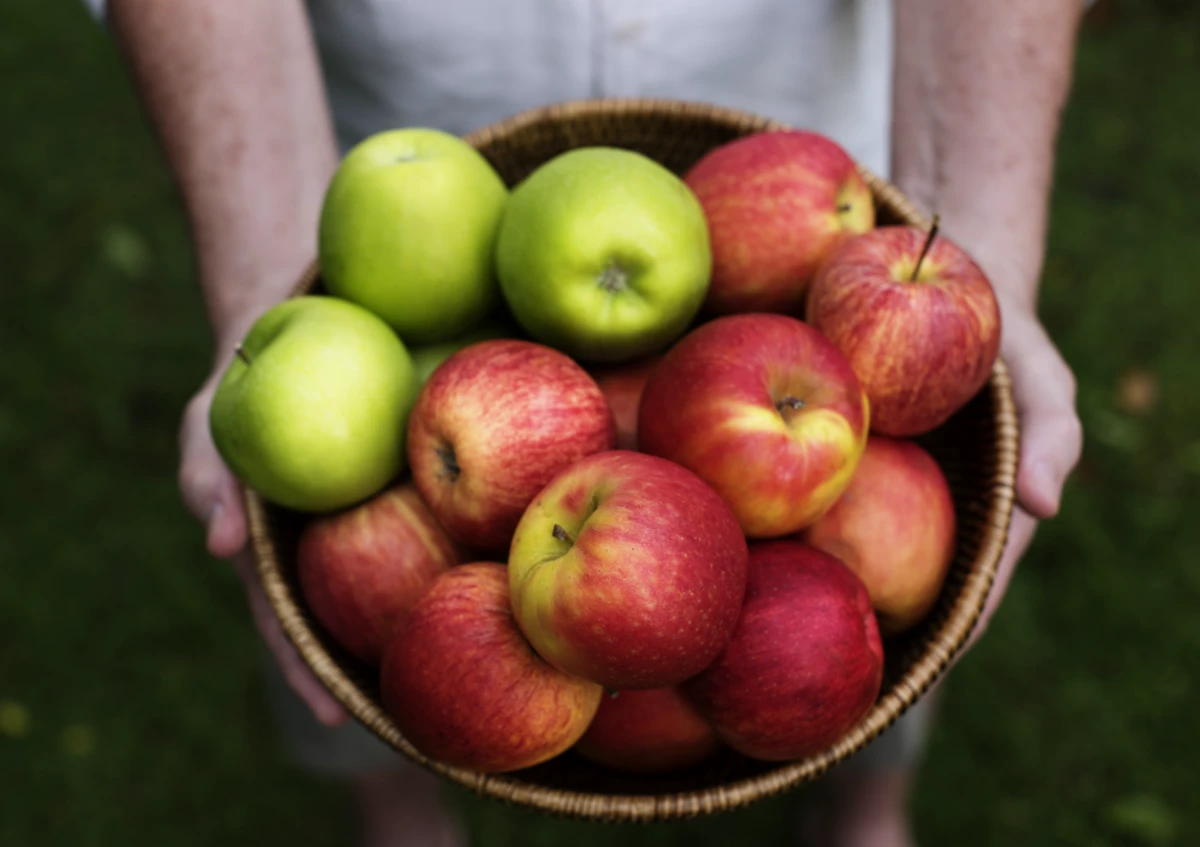Apples are a popular fruit enjoyed worldwide, known for their delicious taste and impressive nutritional profile. One of the key reasons apples are considered an excellent high-fiber food is their combination of soluble and insoluble fiber, which can support various aspects of digestive and heart health. Here’s a breakdown of why apples are one of the best high-fiber foods.
Key Takeaways
| Nutrient | Amount per Medium Apple (182g) |
|---|---|
| Dietary Fiber | 4.4 grams |
| Calories | 95 calories |
| Carbohydrates | 25 grams |
| Sugars | 19 grams (natural sugars) |
| Protein | 0.5 grams |
| Fat | 0.3 grams |
| Vitamin C | 14% of the Daily Value (DV) |
| Potassium | 6% of the DV |
1. Apples are High in Both Soluble and Insoluble Fiber
- Soluble Fiber (Pectin): Apples contain pectin, a type of soluble fiber. Soluble fiber helps slow down digestion, which can help regulate blood sugar and cholesterol levels. It’s particularly beneficial for heart health.
- Insoluble Fiber: This type of fiber adds bulk to the stool and helps promote regular bowel movements, aiding in digestion and preventing constipation.
Fiber Content Comparison (Per Medium Apple)
- Medium Apple (182g): 4.4 grams of fiber
To visualize, that’s about 17% of the daily recommended fiber intake for women and 11% for men (based on a 25g-38g fiber recommendation).
Types of Fiber in Apples:
- Soluble Fiber (about 1-2g per apple): Mostly pectin
- Insoluble Fiber (about 2-3g per apple): Found in the apple skin
2. Apple Nutrition Information
A medium-sized apple offers a wide range of nutrients besides fiber:
- Low in Calories: Just about 95 calories per apple, making it a great low-calorie snack.
- Rich in Antioxidants: Apples are packed with polyphenols, especially in the skin. These compounds are linked to reducing the risk of heart disease and oxidative stress.
- Vitamins and Minerals: Apples provide:
- Vitamin C (14% of the DV)
- Potassium (6% of the DV)
- Small amounts of Vitamin K, Vitamin A, and B vitamins (like folate).
Additional Health Benefits:
- Blood Sugar Regulation: Despite their sugar content, apples have a low glycemic index (GI), which means they have a minimal effect on blood sugar levels. This is due to their high fiber content, particularly soluble fiber, which slows down sugar absorption.
- Heart Health: Studies suggest that the combination of pectin, antioxidants, and potassium in apples supports heart health by lowering LDL (“bad”) cholesterol and maintaining healthy blood pressure.
3. Apples are Suitable for Most Diets
Apples are naturally:
- Vegan
- Gluten-free
- Whole30 compliant (if eaten as whole fruit)
- Paleo-friendly
- Safe for people with lactose intolerance or those on low-FODMAP diets (in small quantities due to fructose content)
- SCD diet-approved for those with ulcerative colitis, in moderation.
Allergies and Sensitivities:
Some people may experience oral allergy syndrome (OAS) with apples, which can cause itching or swelling in the mouth and throat due to a reaction to certain proteins. Cooking or peeling apples can reduce these symptoms.
4. Apple’s Culinary Information
Flavor, Texture, and Aroma:
- Flavor: Apples have a pleasant balance of sweetness and tartness, which varies by variety (e.g., Gala, Fuji, Granny Smith).
- Texture: Crisp and juicy, especially when fresh.
- Aroma: Fresh apples give off a mildly sweet, fruity aroma.
Common Recipes:
- Apple Pie (a classic dessert)
- Apple Cinnamon Oatmeal (for a high-fiber breakfast)
- Apple Slices with Peanut Butter (a high-fiber, high-protein snack)
- Apple and Kale Salad (a fiber-rich side dish)
Storage Tips:
To keep apples fresh:
- Store them in the refrigerator to prevent spoilage. Apples can last up to 4-6 weeks in a cool environment.
- For room temperature storage, they’ll stay fresh for about 1-2 weeks.
- Tip: Keep apples away from other fruits that release ethylene gas (like bananas), as it can cause them to ripen too quickly.
5. FAQ Section
1. How much fiber is in an apple with skin?
A medium-sized apple with skin contains about 4.4 grams of fiber.
2. Is it better to eat apples with or without the skin?
It’s better to eat apples with the skin on, as much of the fiber and antioxidants are concentrated in the skin.
3. Can I eat apples on a low-carb diet?
Apples are relatively high in natural sugars and carbs, so they may not fit well into strict low-carb or ketogenic diets. However, they can be included in moderation in less restrictive low-carb plans.
4. Are apples a good option for people with diabetes?
Yes! Despite their sugar content, apples have a low glycemic index, meaning they won’t cause sharp spikes in blood sugar levels.
5. How do apples support weight loss?
The fiber in apples can help you feel fuller for longer, reducing overall calorie intake and supporting weight management.
6. Are apples safe for people with IBS?
Apples contain fructose, which can trigger IBS symptoms in some individuals, but they are considered low-FODMAP in small portions (about half an apple).
7. What’s the best apple variety for baking?
Granny Smith apples are often preferred for baking because of their tartness and ability to hold their shape.
8. Can apples help lower cholesterol?
Yes, the soluble fiber (pectin) in apples has been shown to help lower LDL cholesterol.
9. How many apples should I eat per day?
One to two apples a day is a healthy amount for most people, offering fiber, vitamins, and antioxidants.
10. Are apples good for gut health?
Yes, both the soluble and insoluble fibers in apples support gut health by promoting regular bowel movements and feeding beneficial gut bacteria.
Conclusion
Apples are not only delicious but also packed with fiber, vitamins, and antioxidants that support overall health. Their combination of soluble and insoluble fiber makes them one of the best high-fiber foods for promoting heart health, blood sugar regulation, and digestive wellness.









